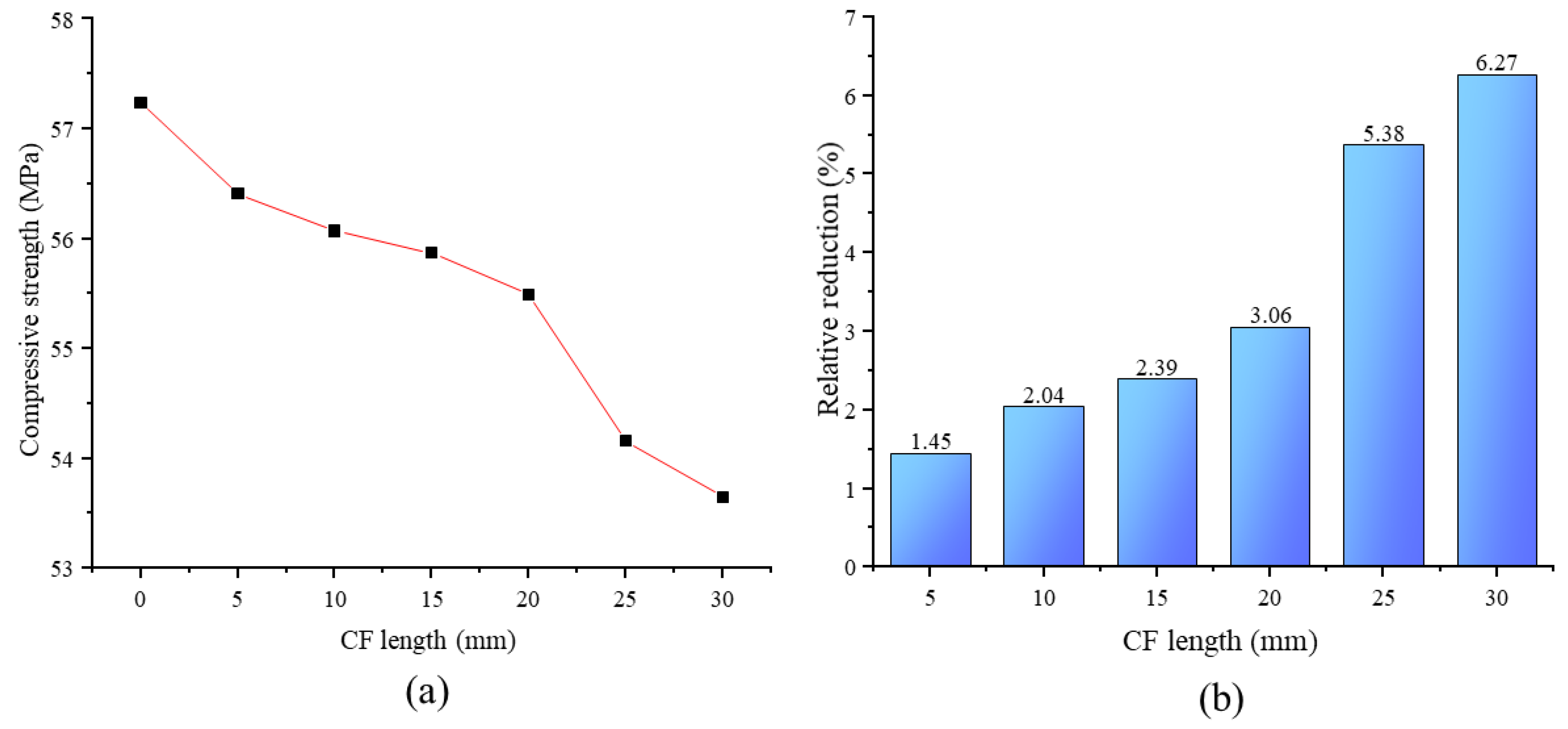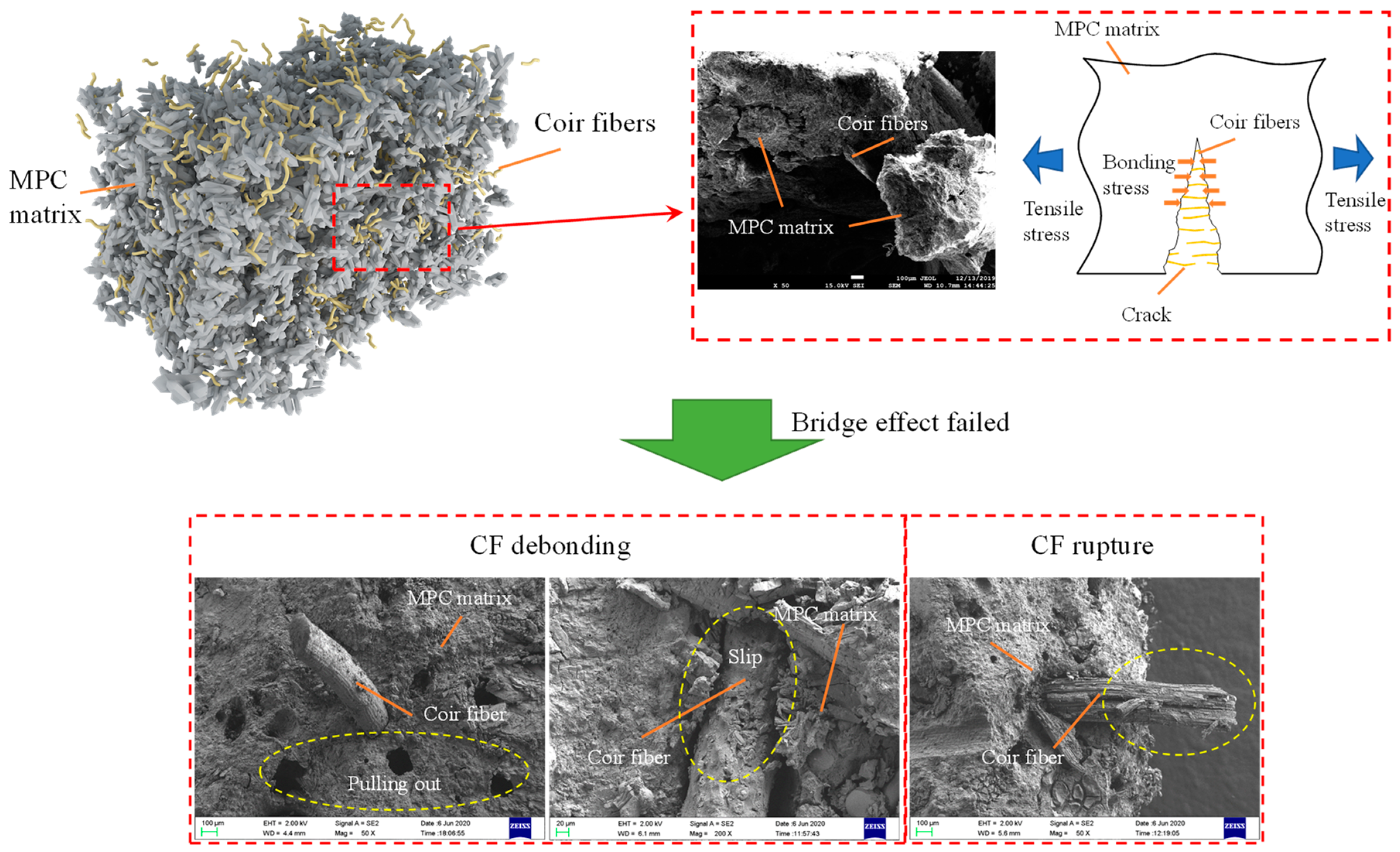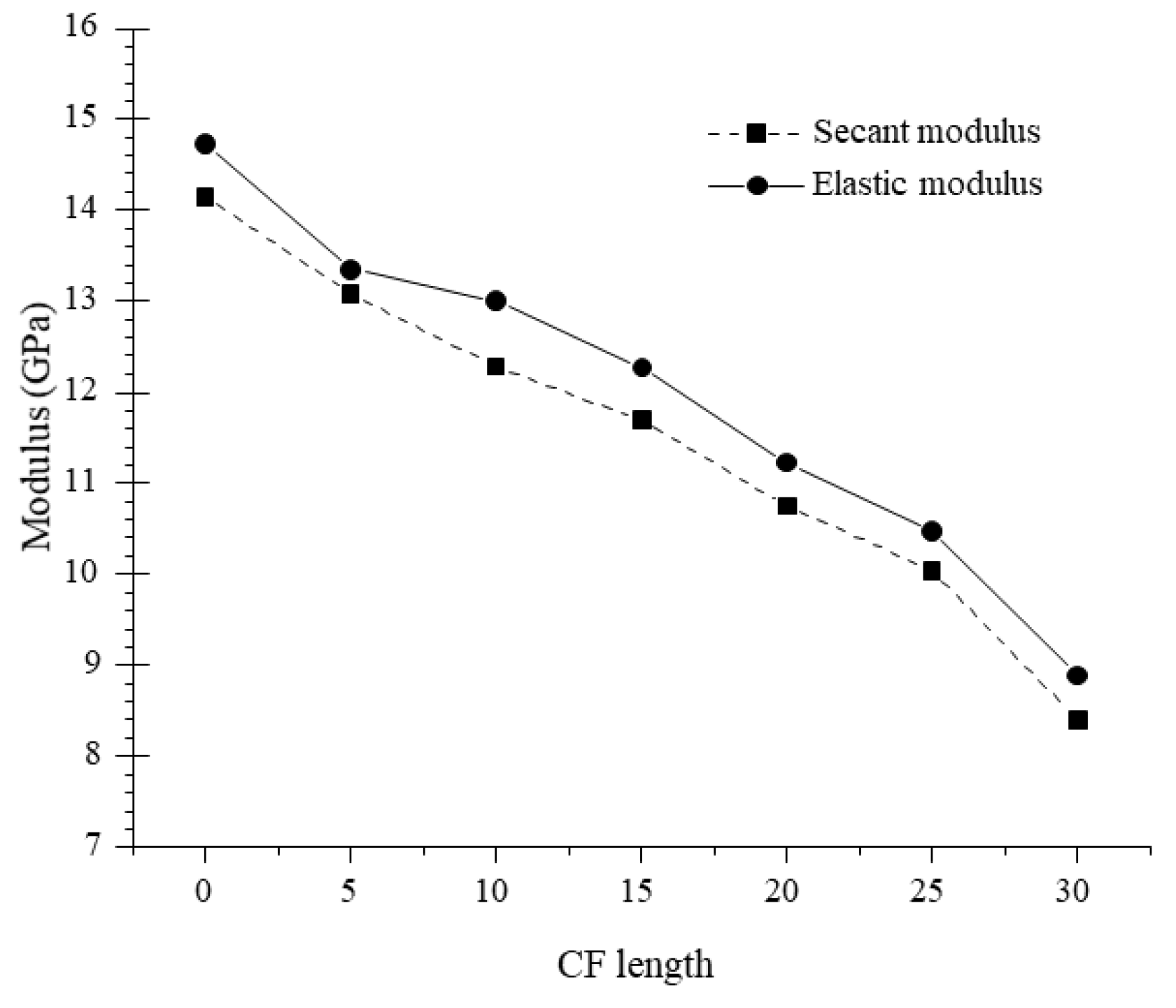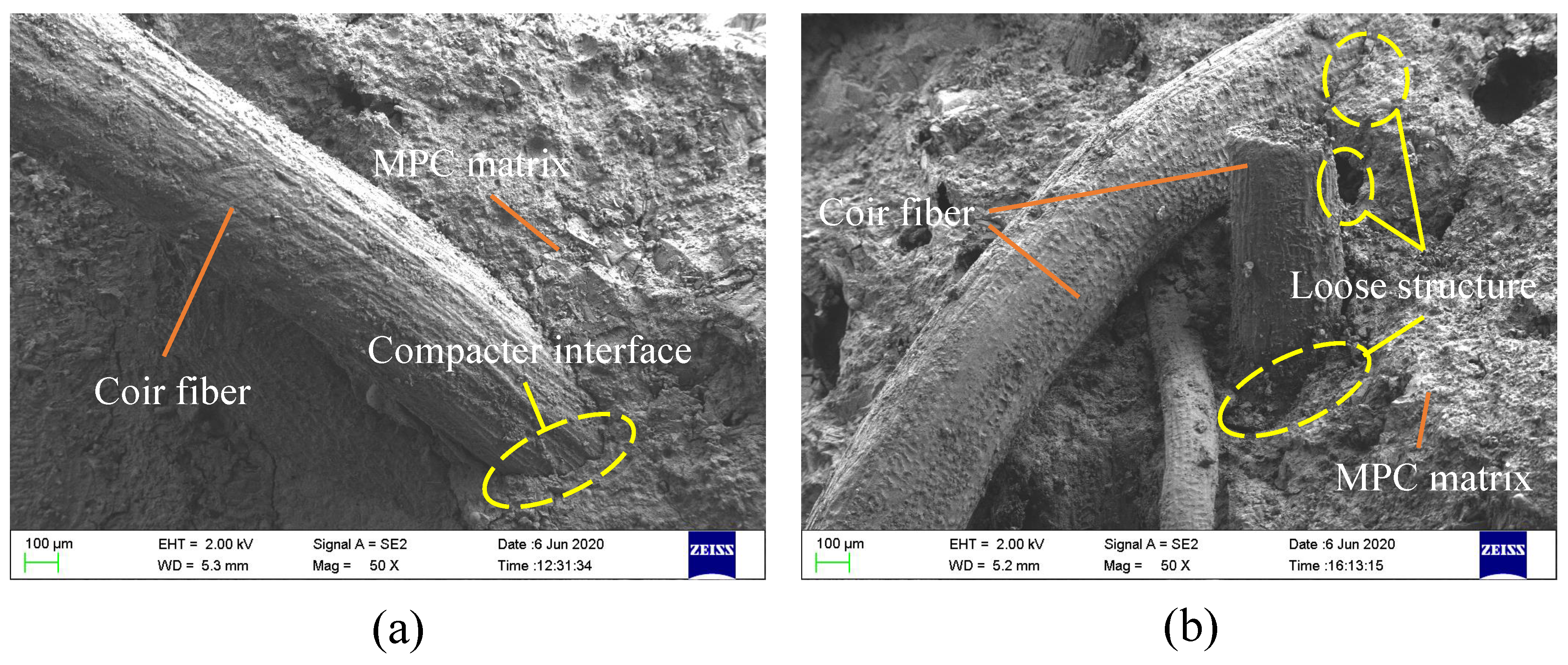Study on the Compressive Properties of Magnesium Phosphate Cement Mixing with Eco-Friendly Coir Fiber Considering Fiber Length
Abstract
:1. Introduction
2. Experimental Program
2.1. Raw Materials
2.2. Specimens and Test Setup
3. Results and Discussion
3.1. Failure Patterns
3.2. Stress–Strain Behavior
3.3. Energy Absorption
4. Conclusions
- (1)
- Adding CF to MPC could effectively increase ductility. When the length of the CF was longer than 10 mm, the failure pattern changed from brittle to ductile.
- (2)
- The addition of CF caused a 6.27% decrease in compressive strength when CF length increased from 0 to 30 mm. The elastic and secant modulus of specimens presented a similar trend as compressive strength, and the plastic properties of MPC showed remarkable improvement.
- (3)
- Adding CF also improves the energy absorption of the MPC, which means increasing the toughness of the MPC. However, this improvement is restricted by CF length. When the length increased to 20 mm, energy absorption reached the maximum value of 230.0 kJ/m3 and increased by 77.0% relative to the value of specimens without CF. Then, it decreased in turn as CF length increased continuously.
Author Contributions
Funding
Acknowledgments
Conflicts of Interest
References
- Roy, D.M. New Strong Cement Materials: Chemically Bonded Ceramics. Science 1987, 235, 651–658. [Google Scholar] [CrossRef] [PubMed]
- Abdelrazig, B.E.I.; Sharp, J.H.; El-Jazairi, B. The chemical composition of mortars made from magnesia phosphate cement. Cem. Concr. Res. 1988, 18, 415–425. [Google Scholar] [CrossRef]
- Qiao, F.; Chau, C.K.; Li, Z. Property evaluation of magnesium phosphate cement mortar as patch repair material. Constr. Build. Mater. 2010, 24, 695–700. [Google Scholar] [CrossRef]
- Yang, Q.B.; Zhu, B.R.; Zhang, S.Q. Properties and applications of magnesia-phosphate cement mortar for rapid repair of concrete. Cem. Concr. Res. 2000, 30, 1807–1813. [Google Scholar] [CrossRef]
- Feng, H.; Chen, G.; Gao, D. Mechanical Properties of Steel Fiber-Reinforced Magnesium Phosphate Cement Mortar. Adv. Civ. Eng. 2018, 3, 1–11. [Google Scholar] [CrossRef]
- Ahmad, M.R.; Chen, B. Effect of silica fume and basalt fiber on the mechanical properties and microstructure of magnesium phosphate cement (MPC) mortar. Constr. Build. Mater. 2018, 190, 466–478. [Google Scholar] [CrossRef]
- Fang, Y.; Cui, P.; Ding, Z.; Zhu, J.X. Properties of a magnesium phosphate cement-based fire-retardant coating containing glass fiber or glass fiber powder. Constr. Build. Mater. 2018, 162, 553–560. [Google Scholar] [CrossRef]
- Ahmad, M.R.; Chen, B.; Haque, M.A.; Shah, S.F.A. Development of a sustainable and innovant hygrothermal bio-composite featuring the enhanced mechanical properties. J. Clean. Prod. 2019, 229, 128–143. [Google Scholar] [CrossRef]
- Lecompte, T.; Perrot, A.; Subrianto, A. A novel pull-out device used to study the influence of pressure during processing of cement-based material reinforced with coir. Constr. Build. Mater. 2015, 78, 224–233. [Google Scholar] [CrossRef]
- Paul, A.; Thomas, S. Electrical properties of natural-fiber-reinforced low-density polyethylene composites: A comparison with carbon black and glass-fiber-filled low-density polyethylene composites. J. Appl. Polym. Sci. 1997, 63, 247–266. [Google Scholar] [CrossRef]
- Ali, M.; Liu, A.; Sou, H.; Chouw, N. Mechanical and dynamic properties of coconut fiber reinforced concrete. Constr. Build. Mater. 2012, 30, 814–825. [Google Scholar] [CrossRef]
- Ali, M.; Li, X.Y.; Chouw, N. Experimental investigations on bond strength between coconut fiber and concrete. Mater. Des. 2013, 44, 596–605. [Google Scholar] [CrossRef]
- Baruah, P.; Talukdar, S. A comparative study of compressive, flexural, tensile and shear strength of concrete with fibres of different origins. Indian Concr. J. 2007, 81, 17–24. [Google Scholar]
- Thanushan, K.; Yogananth, Y.; Sangeeth, P.; Coonghe, J.G.; Sathiparan, N. Strength and Durability Characteristics of Coconut Fiber Reinforced Earth Cement Blocks. J. Nat. Fibers 2019, 1–16. [Google Scholar] [CrossRef]
- Li, Z.J.; Wang, L.J.; Wang, X.G. Flexural Characteristics of Coir Fiber Reinforced Cementitious Composites. Fiber. Polym. 2006, 7, 286–294. [Google Scholar] [CrossRef] [Green Version]
- Sekar, A.; Kandasamy, G. Optimization of Coconut Fiber in Coconut Shell Concrete and Its Mechanical and Bond Properties. Materials 2018, 11, 1726. [Google Scholar] [CrossRef] [Green Version]
- Hwang, C.L.; Tran, V.A.; Hong, J.W. Effects of short coconut fiber on the mechanical properties, plastic cracking behavior, and impact resistance of cementitious composites. Constr. Build. Mater. 2016, 127, 984–992. [Google Scholar] [CrossRef]
- Fang, Y.; Chen, B.; Oderji, S.Y. Experimental research on magnesium phosphate cement mortar reinforced by glass fiber. Constr. Build. Mater. 2018, 188, 729–736. [Google Scholar] [CrossRef]
- ASTM C109-16. Standard Test Method for Compressive Strength of Hydraulic Cement Mortars; American Society for Testing and Materials, ASTM International: West Conshohocken, PA, USA, 2016. [Google Scholar]
- ASTM C469-14. Standard Test Method for Static Modulus of Elasticity and Poisson’s Ratio of Concrete in Compression; American Society for Testing and Materials, ASTM International: West Conshohocken, PA, USA, 2014. [Google Scholar]
- Xu, B.W.; Lothenbach, B.; Leemann, A.; Winnefeld, F. Reaction mechanism of magnesium potassium phosphate cement with high magnesium-to-phosphate ratiod. Cem. Concr. Res. 2018, 108, 140–151. [Google Scholar] [CrossRef]
- Estabragh, A.R.; Ranjbari, S.; Javadi, A.A. Properties of Clay Soil and Soil Cement Reinforced with Polypropylene Fibers. ACI Mater. J. 2017, 114, 195–205. [Google Scholar] [CrossRef]
- Swamy, P.A.V.B. Efficient inference in a random coefficient regression model. Econometrica 1970, 38, 311–323. [Google Scholar] [CrossRef]












| Composition | MgO | Al₂O₃ | Fe₂O₃ | CaO | SiO₂ | Loss |
|---|---|---|---|---|---|---|
| wt % | 96.25 | 0.29 | 1.09 | 1.18 | 1.16 | 0.03 |
| Composition | SiO₂ | Al₂O₃ | Fe₂O₃ | CaO | TiO₂ | Loss |
|---|---|---|---|---|---|---|
| wt % | 56.74 | 24.58 | 6.55 | 4.87 | 1.86 | 5.4 |
| ASTM C618 (%) | ≥70 | - | - | ≤6 | ||
| Diameter (µm) | Density (kg/m3) | Moisture Content (%) | Length (mm) | Tensile Strength (MPa) | Tensile Modulus (GPa) | Elongation at Break (%) |
|---|---|---|---|---|---|---|
| 150–350 | 1200 | 10–12 | 5–30 | 128–157 | 3.86–5.60 | 21.2–40.7 |
| Group | Specimen Number | MPC Binder (Mass Ratio) | B/M 1 (%) | W/BM 2 (%) | Volume Fraction 3 (Vf, %) | Fiber Length (mm) | ||
|---|---|---|---|---|---|---|---|---|
| MgO | KH2PO4 | Fly Ash | ||||||
| CFL0 | SC-CFL0-1 | 1.0 | 0.68 | 0.25 | 10 | 15 | 3.0 | 0.0 |
| SC-CFL0-2 | ||||||||
| SC-CFL0-3 | ||||||||
| CFL5 | SC-CFL5-1 | 5.0 | ||||||
| SC-CFL5-2 | ||||||||
| SC-CFL5-3 | ||||||||
| CFL10 | SC-CFL10-1 | 10.0 | ||||||
| SC-CFL10-2 | ||||||||
| SC-CFL10-3 | ||||||||
| CFL15 | SC-CFL15-1 | 15.0 | ||||||
| SC-CFL15-2 | ||||||||
| SC-CFL15-3 | ||||||||
| CFL20 | SC-CFL20-1 | 20.0 | ||||||
| SC-CFL20-2 | ||||||||
| SC-CFL20-3 | ||||||||
| CFL25 | SC-CFL25-1 | 25.0 | ||||||
| SC-CFL25-2 | ||||||||
| SC-CFL25-3 | ||||||||
| CFL30 | SC-CFL30-1 | 30.0 | ||||||
| SC-CFL30-2 | ||||||||
| SC-CFL30-3 | ||||||||
© 2020 by the authors. Licensee MDPI, Basel, Switzerland. This article is an open access article distributed under the terms and conditions of the Creative Commons Attribution (CC BY) license (http://creativecommons.org/licenses/by/4.0/).
Share and Cite
Jiang, Z.; Zhang, L.; Geng, T.; Lai, Y.; Zheng, W.; Huang, M. Study on the Compressive Properties of Magnesium Phosphate Cement Mixing with Eco-Friendly Coir Fiber Considering Fiber Length. Materials 2020, 13, 3194. https://doi.org/10.3390/ma13143194
Jiang Z, Zhang L, Geng T, Lai Y, Zheng W, Huang M. Study on the Compressive Properties of Magnesium Phosphate Cement Mixing with Eco-Friendly Coir Fiber Considering Fiber Length. Materials. 2020; 13(14):3194. https://doi.org/10.3390/ma13143194
Chicago/Turabian StyleJiang, Zuqian, Liwen Zhang, Tao Geng, Yushan Lai, Weile Zheng, and Min Huang. 2020. "Study on the Compressive Properties of Magnesium Phosphate Cement Mixing with Eco-Friendly Coir Fiber Considering Fiber Length" Materials 13, no. 14: 3194. https://doi.org/10.3390/ma13143194
APA StyleJiang, Z., Zhang, L., Geng, T., Lai, Y., Zheng, W., & Huang, M. (2020). Study on the Compressive Properties of Magnesium Phosphate Cement Mixing with Eco-Friendly Coir Fiber Considering Fiber Length. Materials, 13(14), 3194. https://doi.org/10.3390/ma13143194





